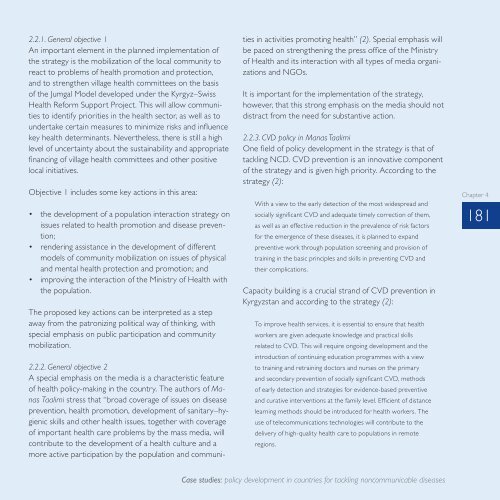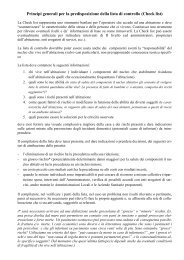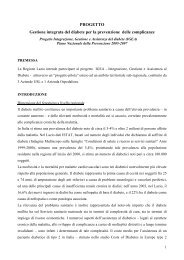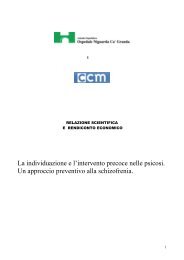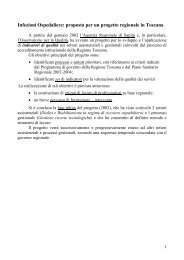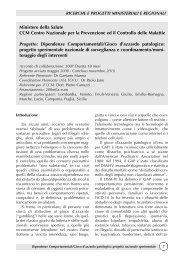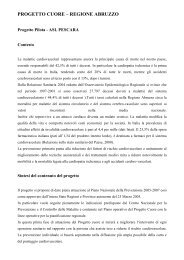Gaining health : analysis of policy development in European ...
Gaining health : analysis of policy development in European ...
Gaining health : analysis of policy development in European ...
You also want an ePaper? Increase the reach of your titles
YUMPU automatically turns print PDFs into web optimized ePapers that Google loves.
2.2.1. General objective 1<br />
An important element <strong>in</strong> the planned implementation <strong>of</strong><br />
the strategy is the mobilization <strong>of</strong> the local community to<br />
react to problems <strong>of</strong> <strong>health</strong> promotion and protection,<br />
and to strengthen village <strong>health</strong> committees on the basis<br />
<strong>of</strong> the Jumgal Model developed under the Kyrgyz–Swiss<br />
Health Reform Support Project. This will allow communities<br />
to identify priorities <strong>in</strong> the <strong>health</strong> sector, as well as to<br />
undertake certa<strong>in</strong> measures to m<strong>in</strong>imize risks and <strong>in</strong>fluence<br />
key <strong>health</strong> determ<strong>in</strong>ants. Nevertheless, there is still a high<br />
level <strong>of</strong> uncerta<strong>in</strong>ty about the susta<strong>in</strong>ability and appropriate<br />
f<strong>in</strong>anc<strong>in</strong>g <strong>of</strong> village <strong>health</strong> committees and other positive<br />
local <strong>in</strong>itiatives.<br />
Objective 1 <strong>in</strong>cludes some key actions <strong>in</strong> this area:<br />
• the <strong>development</strong> <strong>of</strong> a population <strong>in</strong>teraction strategy on<br />
issues related to <strong>health</strong> promotion and disease prevention;<br />
• render<strong>in</strong>g assistance <strong>in</strong> the <strong>development</strong> <strong>of</strong> different<br />
models <strong>of</strong> community mobilization on issues <strong>of</strong> physical<br />
and mental <strong>health</strong> protection and promotion; and<br />
• improv<strong>in</strong>g the <strong>in</strong>teraction <strong>of</strong> the M<strong>in</strong>istry <strong>of</strong> Health with<br />
the population.<br />
The proposed key actions can be <strong>in</strong>terpreted as a step<br />
away from the patroniz<strong>in</strong>g political way <strong>of</strong> th<strong>in</strong>k<strong>in</strong>g, with<br />
special emphasis on public participation and community<br />
mobilization.<br />
2.2.2. General objective 2<br />
A special emphasis on the media is a characteristic feature<br />
<strong>of</strong> <strong>health</strong> <strong>policy</strong>-mak<strong>in</strong>g <strong>in</strong> the country. The authors <strong>of</strong> Manas<br />
Taalimi stress that “broad coverage <strong>of</strong> issues on disease<br />
prevention, <strong>health</strong> promotion, <strong>development</strong> <strong>of</strong> sanitary–hygienic<br />
skills and other <strong>health</strong> issues, together with coverage<br />
<strong>of</strong> important <strong>health</strong> care problems by the mass media, will<br />
contribute to the <strong>development</strong> <strong>of</strong> a <strong>health</strong> culture and a<br />
more active participation by the population and communities<br />
<strong>in</strong> activities promot<strong>in</strong>g <strong>health</strong>” (2). Special emphasis will<br />
be paced on strengthen<strong>in</strong>g the press <strong>of</strong>fice <strong>of</strong> the M<strong>in</strong>istry<br />
<strong>of</strong> Health and its <strong>in</strong>teraction with all types <strong>of</strong> media organizations<br />
and NGOs.<br />
It is important for the implementation <strong>of</strong> the strategy,<br />
however, that this strong emphasis on the media should not<br />
distract from the need for substantive action.<br />
2.2.3. CVD <strong>policy</strong> <strong>in</strong> Manas Taalimi<br />
One field <strong>of</strong> <strong>policy</strong> <strong>development</strong> <strong>in</strong> the strategy is that <strong>of</strong><br />
tackl<strong>in</strong>g NCD. CVD prevention is an <strong>in</strong>novative component<br />
<strong>of</strong> the strategy and is given high priority. Accord<strong>in</strong>g to the<br />
strategy (2):<br />
With a view to the early detection <strong>of</strong> the most widespread and<br />
socially significant CVD and adequate timely correction <strong>of</strong> them,<br />
as well as an effective reduction <strong>in</strong> the prevalence <strong>of</strong> risk factors<br />
for the emergence <strong>of</strong> these diseases, it is planned to expand<br />
preventive work through population screen<strong>in</strong>g and provision <strong>of</strong><br />
tra<strong>in</strong><strong>in</strong>g <strong>in</strong> the basic pr<strong>in</strong>ciples and skills <strong>in</strong> prevent<strong>in</strong>g CVD and<br />
their complications.<br />
Capacity build<strong>in</strong>g is a crucial strand <strong>of</strong> CVD prevention <strong>in</strong><br />
Kyrgyzstan and accord<strong>in</strong>g to the strategy (2):<br />
To improve <strong>health</strong> services, it is essential to ensure that <strong>health</strong><br />
workers are given adequate knowledge and practical skills<br />
related to CVD. This will require ongo<strong>in</strong>g <strong>development</strong> and the<br />
<strong>in</strong>troduction <strong>of</strong> cont<strong>in</strong>u<strong>in</strong>g education programmes with a view<br />
to tra<strong>in</strong><strong>in</strong>g and retra<strong>in</strong><strong>in</strong>g doctors and nurses on the primary<br />
and secondary prevention <strong>of</strong> socially significant CVD, methods<br />
<strong>of</strong> early detection and strategies for evidence-based preventive<br />
and curative <strong>in</strong>terventions at the family level. Efficient <strong>of</strong> distance<br />
learn<strong>in</strong>g methods should be <strong>in</strong>troduced for <strong>health</strong> workers. The<br />
use <strong>of</strong> telecommunications technologies will contribute to the<br />
delivery <strong>of</strong> high-quality <strong>health</strong> care to populations <strong>in</strong> remote<br />
regions.<br />
Chapter 4<br />
181<br />
Case studies: <strong>policy</strong> <strong>development</strong> <strong>in</strong> countries for tackl<strong>in</strong>g noncommunicable diseases


